Mount Waddington and British Columbia's Coast Range
by Coley Gentzel
Former AAI Instructor and Guide
Waddington! - Just the name quickens the heartbeat of any alpinist who has happened upon an article or even photo of this mysterious and remarkable peak. Mount Waddington? Does it really exist or is it just a tall tale? If it does exist, it's at the very least a place that very few people know much about, where very few people have been, and information about which is somewhat limited and hard to find. Climbers that have been to the range often speak of the place with an animation and excitement warranted by only a few great ranges in the world. In my mind Waddington and the remote parts of the Coast Range have always seemed like places that ordinary climbers can't go: too remote, too difficult, and too involved. Like the mountains in places that end in "ikstan" or "onia". Unattainable for the mere mortal.
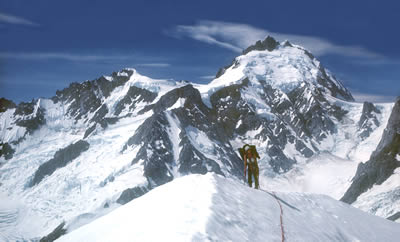
Mount Waddington as seen from the southeast. Bruce Pratt
A few years back, after one of the American Alpine Institute's trips returned from an attempt on Mt. Waddington, my interest in the place was piqued slightly beyond surface level curiosity. Speaking with the guides and climbers who had been on the trip, hearing them talk about the peaks and glaciers, and seeing the profound effect that spending time in this great range had on each of the climbers and guides, I began to wonder a bit more seriously about what was really involved with climbing on and around Mt. Waddington.
In the past, climbers and adventurers alike looking to research possibilities in the range had to resort to digging through past volumes of the Canadian and American Alpine Journals, climbing magazines, and piles of fruitless Google results. Not any more. Thanks to Don Serl and the good folks at Elaho Press in Squamish, BC, alpinists everywhere now have "The Waddington Guide: Alpine Climbs in one of the World's Great Ranges." Timberline Forest Inventory Consultants have also published an excellent map of the area.
Where in the World?
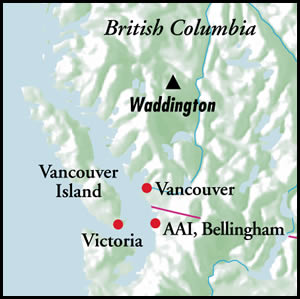
Mount Waddington is located deep in British Columbia's Coast Range.
Mt. Waddington (13,186 ft.) and the peaks that surround it are in British Columbia's Coast Range, which originates on the north side of the Fraser River Valley (near Vancouver B.C.) and runs almost a thousand miles along the coast of western Canada to end in the Yukon Territories near Skagway. The term "Waddington Range" refers to Mt. Waddington and the nearby peaks that make up the most spectacular sub-section of the Coast Range. The Coast Range has a reputation, amongst Northwest climbers and those who have heard the tales, for being hard to get to. Modern advances in transportation options (helicopters) have replaced this difficulty with expense.
The terrain, mountains, and forests in much of the Pacific Northwest and British Columbia are so dense and complex that Waddington and its surrounding peaks are not visible from any easily accessed point on the West Coast. Supposedly the closest point to Vancouver from which you can see Waddington is a peak called Ashlu which lies just north of the town of Squamish and south of the famous ski destination of Whistler.
Quite a few years back some friends and I made an attempt to climb Ashlu. I would be embarrassed to call the effort a climbing attempt, as we never even laid eyes on the peak. We threw in the towel after bushwacking (both with vehicle and by foot) for several hours, wandering aimlessly in a dense and foggy forest, and finally accepted defeat after a bout of vertical root climbing in a mini-waterfall. After nursing our wounded pride and inventing a few reasons for why the failed attempt was not a reflection on our self-perceived climbing abilities, we learned that the peak had only been climbed once before. I guess that explains the lack of trail and accurate approach directions.
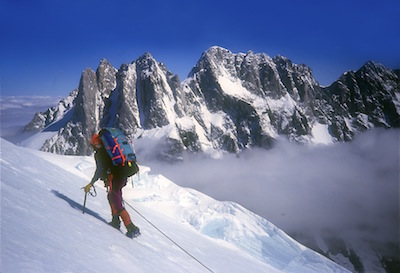
Ascending the Bravo Glacier on Waddington with Combatant
and Tiedemann in the background. Michael Powers
"You Can't Get There from Here"
Well, actually you can. From the western side of the US or Canada, the easiest way to reach the Waddington group is to drive to one of a few towns that hosts an air service with flights into the range, and charter a flight. Tatla Lake (Bluff Lake) is one such town; it's a 10-hour drive from Vancouver. From your jumping off point at Bluff Lake, it's an hour helicopter flight to most parts of the range including your base camp for Mt. Waddington. Gas to Bluff Lake: $32.20. Food for a 2 week climbing trip: $250. Getting dropped off at the base of one of the most spectacular mountains in North America: priceless. Well, not exactly. You will pay heftily for the helicopter ride in but most say it's worth it. If flying is too rich for your blood, you may want to schedule another two weeks for your Waddington trip, polish up your cursing skills, and invest in a kevlar suit. The alternative to a heli ride is to bushwack 18 miles from the ocean.
A Brief History of Waddington Climbing
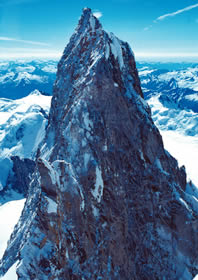
Mount Waddington's true summit from the lower Northwest summit.
Because of its remote location deep within a large mountain range, Waddington was not even "discovered" by modern cartographers until the mid-1920's. Don and Phyllis Munday, Canadian climbers and geographers, first spied the mountain from more than 150 miles away on Vancouver Island, and quickly made plans for an exploratory climb. They succeeded in reaching the lower, Northwest Summit in 1928. The true summit, however, remained unclimbed, and quickly entered the consciousness of elite alpinists as a major plum to be picked.
After several attempts by other strong parties, one of which ended in a fatality, the prize was finally taken by Fritz Wiessner and Bill House in 1936. Wiessner, who had immigrated from Germany only seven years earlier, was a strong rock climber, trained on the hard sandstone routes near Dresden, where modern free climbing was born. His successful leadership on the South Face, climbing 5.7 moves on rime-covered rock wearing only rope-soled espadrilles for rock shoes, put Waddington on the map definitively as the hardest climb in North America.
Waddington's second ascent, in 1942, was almost as historic as the first. The now-lengendary Fred Beckey – then only nineteen years old and an unknown outside of the Seattle climbing scene – and his younger brother Helmy repeated the South Face route Wiessner and House had climbed.
Indeed, the list of first ascentionists in the Waddington Range reads more like a who's who of high-standard climbing through the eras. Names like Munday, Beckey, Peter Croft, Allen Steck, Don Serl, Conrad Anker, and Jack Tackle are attached to some of the plums that were picked in the Waddington Range first. Because of involved planning, knowledge, and skills required, as well as the relative difficulty of the area's most aesthetic routes, Waddington and its neighbors attract few numbers but a relatively high caliber of climber and mountaineer. The profile of the mountain with the climbing public was raised when it was included in Roper and Steck's Fifty Classic Climbs; but then, the Waddington Range has always been, and probably always will be, famous for its high standard mountaineering and rock climbing objectives. Surprisingly, in spite of this notoriety, there are a number of good routes on rock and glacier for every category of adventurer, from novice to expert and you need not be a modern hardman or woman to contemplate a trip into the range.
The American Alpine Institute has successfully guided two complete ascents to the true summit of Mt. Waddington, and four others to the scenic and challenging Northwest summit. The Northwest summit is slightly lower and technically easier to reach than the true summit. The author of the aforementioned guidebook claims, in his research, to have uncovered only 6 recorded ascents of Waddington ending on the true summit. There may now be more, but this is still a testament to the relative difficulty and challenge in climbing the peak. You can read an excerpt detailing the ascent of the main peak from our "Summer 1995" newsletter here.
Highlights of the Range - Classic Routes
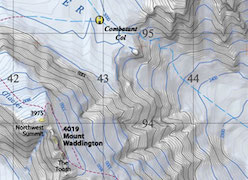
A detail of the new Waddington Map
Topo of the Waddington Range* (sample portion of Timberline's map)
*Reproduced courtesy of Timberline Forest Inventory Consultants. The Waddington Guide is available for purchase at our gear shop, shop.alpineinstitute.com.
Easier Routes
- Mt Waddington, The Kiwi Route
The easiest way to reach the summit from the Waddington-Combatant col. Climbers going to the true summit will always be faced with the technical difficulties of the summit pyramid, 5.7 rock climbing (oftentimes icy). The route to Waddingtons lower, Northwest summit, along this route, will involve snow and ice climbing to 55 degrees.
- Mt Combatant, Northwest Ridge
A straight forward snow climb with mid-fifth class rock climbing on one of the significant summits of the range.
- Mt Tiedemann, BCMC Route
The most logical route on Tiedemann from the North. 50 degree snow climbing in a couloir is followed by some mixed climbing in the mid-fifth range and then a snow arete to the summit. A great mountaineering route.
Harder Routes
- Mt. Waddington, South Face (Bravo Glacier Route)
Technically, the aspect is southwest, not south. This was the first ascent route used by Weissner and House and the one climbed twice by AAI teams to reach the true summit. Difficulties lie in the 5.7 rating, with 50 degree snow and ice, but the seriousness of the route should not be gauged on technical difficulty alone. Weather and objective hazard necessitate speed. The rock is often coated in rime ice or verglas, adding dramatically to the difficulty. Any route on Waddington should be considered very committing and long.
- Mt. Combatant, The Skywalk Buttress
Likened to great classics like the Beckey-Chouinard route in the Bugaboos and the Steck-Salathe in Yosemite, the Skywalk Buttress is considered one of the great rock climbs of North America. Given a commitment grade 5 (ED1), Skywalk is 16 pitches of superb crack climbing on almost flawless granite. Most of the climbing is in the 5.8-5.9 range.
- Mt. Munday, North Face
A superb North Face ice climb on one of the lesser summits near Waddington. Sustained snow and ice in the 50-60 degree range with some steeper sections. Some serac and avalanche threat.
Want to go?
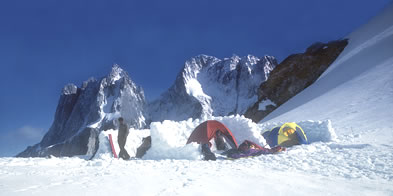
Basecamp on the glacier with Mounts Combatant and Teidemann in the background. Michael Powers
AAI runs expeditions to the Waddington Range as the culminating 12-day segment of our core 48-day Alpine Mountaineering and Technical Leadership Course. We also arrange a private guided Mt. Waddington climb upon request. AAI's guides and clients are responsible for two of the six "recorded" ascents (as of this writing) of Mt Waddington's main summit. AAI teams have made four other successful ascents of the Northwest summit. Climbers with extensive climbing and mountaineering experience may qualify for the expedition without the need for additional training, while other climbers may need to participate in Parts 1 and/or 2 of our Alpine Mountaineering and Technical Leadership course. Private trips can be arranged upon request. Please call for more information on Waddington or any of AAI's other worldwide expeditions and climbs.
Click the link to see American Alpine Institute's complete alpine climbing course offerings.
Program Finder